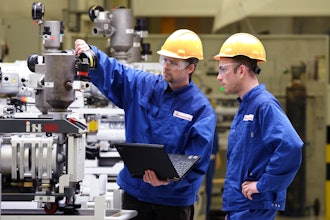
It is estimated that 66 percent of manufacturing organizations are expecting output to rise in 2021. With production increasing and workplace capacity levels remaining around 50 percent, managers at manufacturing companies will need to ensure their teams are reskilled, retrained and adequately certified so they can take on multiple roles as they navigate through the rest of the pandemic.
With limited options regarding on-site training, much of this high-priority training in the manufacturing sector must be conducted remotely to ensure employees can keep up with higher production demand. Today's latest learning and development tech can help to ensure employees stay updated on new tools, policies and technology, all from home.
Due to the diverse nature of the deskless workforce, many do not have access to other industries' training methods. Learning and development processes can be difficult to implement in industries that heavily rely on a deskless workforce' (like much of the manufacturing sector). However, it is still critical to keep employees safe, engaged and in compliance to boost productivity and reduce turnover.
We at Manufacturing.net recently spoke with Bob Greene, senior human resource industry analyst at Ascentis — a SaaS human capital management provider — about how leveraging the right tech offers managers customizable learning solutions that can be tailored to match any manufacturing facility's business skills, software training and compliance requirements.
Manufacturing.net: How has COVID-19 changed the way training, reskilling and compliance certifications are being handled in the manufacturing industry?
 Greene
Greene
Manufacturing.net: Why should manufacturers be focused on reskilling and upskilling their employees rather than hiring new talent?
Greene: Focusing on reskilling and upskilling workers can help improve productivity and efficiency while keeping costs low, ultimately improving profitability. It is crucial to keep in mind that the turnover rate for manufacturing employees is toward the higher end at 20 percent, so hiring new employees also comes with the risk that they may not remain with the company for long.
Hiring new workers also takes up a significant amount of time. Companies benefit from Workforce Management tools to find those experienced, reskilled employees, capable of filling multiple positions, to quickly fill those unplanned absences while minimizing impact on production. Reskilling and upskilling employees can boost productivity without spending a large amount of money and allows manufacturing factories to be more profitable in the long run. In the end, it is more cost-effective and time-efficient to upskill current employees so they can take on multiple roles and responsibilities rather than bring in new talent.
Manufacturing.net: What are some of the ways and methods manufacturing companies are safely and effectively training new employees during a pandemic?
 iStock
iStock
It’s also good to point out that Biometric readers provide innovative solutions for highly secure environments; however, their use is limited when a job requires a mask or other personal protective equipment. Aligning with the Centers for Disease Control and Prevention guidelines, many businesses have instituted touchless clock-in practices, where feasible. Leveraging alternative clock-in processes that remain touchless and using hardware designed to scan employee temperatures produces safer working environments.
Manufacturing.net: How can manufacturers ensure both deskless/shift employees and remote workforces are being adequately trained and certified?
Greene: It is essential for manufacturing organizations to assist workers that may not have a dedicated workspace or access to a computer. Today's learning and development software is accessible on a smart device, allowing employees to successfully conduct training on their phone or tablet if they do not have access to a computer. Managers can go the extra mile by providing deskless workers with smart tablets that they can use to complete their training. Smart tablets are also more cost-efficient than traditional timeclocks, meaning employers can buy more and ensure all deskless employees can access them. Since most employers will want to deploy “communal” tablets tasked for training separately from those used for time management and building access, some employers may want to set up a dedicated “learning lab” or “learning annex” with cubicles, each with an immobilized tablet, for training employees who have no smart equipment of their own.
Manufacturers are investing in more modern technology. What is the best method for training employees on how to use new, more hands-on technology?
While training for new technologies should always feature an onsite component, employers can begin the training process virtually. This allows everyone to save more time when it comes to hands-on training since employees will already have a grasp of the basics. Learning and development technology can cover essential aspects of new technologies through videos and whitepapers. And bear in mind that the best modern LMS components, being SCORM-compliant (Shareable Content Object Reference Model), includes the ability to administer quizzes, tests and final exams throughout the training process, ensuring comprehension is achieved when remote access is being utilized.
Implementing a blended training style during COVID-19 can ensure employees are adequately reskilled for modern technologies while maintaining social distancing compliance. Best practices include scheduling in-person training for new technology and machinery for employees in an alternating fashion to ensure social distancing protocols are being met.
Manufacturing.net: A report from the National Skills Coalition found that one in three manufacturing workers have limited or no digital skills. How can managers help less technology-oriented workers navigate a more modern manufacturing environment?
Greene: An online learning management system can accommodate those with limited to no digital skills through customizable training programs with software that can adapt to the technological capabilities of its users. It is common for less technology-oriented employees to feel intimidated by the thought of conducting training on their own. Today’s learning and development technology allows employees to work at their own pace and ensure they always have access to their learning portals or automated learning assistant, if available, should any questions arise.
Manufacturing.net: Can reskilling and compliance training be handled differently? If so, how and what are some key considerations as companies seek out WFM tools to support their Learning and Development initiatives?
Greene: Yes, through frequent, cost-effective pandemic-friendly training, employees can maintain compliance at a higher level than before. It is vital to pick a workforce management software that continuously updates to fit the changing standards of federal, local, and state regulations, allowing employees to be quickly informed on any additions or changes to policies. Failing to maintain compliance can cause many risks, so manufacturing employees must maintain current certifications to reduce regulatory risks.
Manufacturing.net: How can manufacturers better engage employees to make virtual training more interesting?
Greene: Virtual training should not be a one-way street where an employee is mindlessly clicking through the material. Modern learning management solutions, particularly those which are SCORM compliant, have enforced pacing, preventing employees from skimming ahead and allowing managers to provide detailed feedback. It is critical to keep manufacturing employees engaged throughout the virtual training process. Learning management systems can do this by delivering appealing content from multiple sources and providers and offering fun — never “threatening” — quizzes and tests of knowledge offering plenty of virtual “pats on the back” for correct answers. Detailed feedback and an extensive library of training content from different vendors will also help employees understand the material and retain more.






















